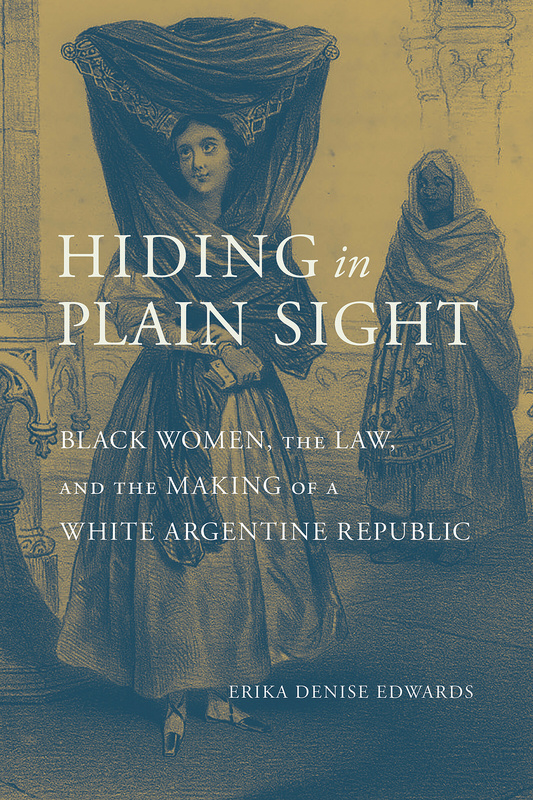
Hiding in Plain Sight
Black Women, the Law, and the Making of a White Argentine Republic
2021 Finalist for the Harriet Tubman Book Prize
2020 Finalist Berkshire Conference of Women Historians Book Prize
Details how African-descended women’s societal, marital, and sexual decisions forever reshaped the racial makeup of Argentina
Argentina promotes itself as a country of European immigrants. This makes it an exception to other Latin American countries, which embrace a more mixed—African, Indian, European—heritage. Hiding in Plain Sight: Black Women, the Law, and the Making of a White Argentine Republic traces the origins of what some white Argentines mischaracterize as a “black disappearance” by delving into the intimate lives of black women and explaining how they contributed to the making of a “white” Argentina. Erika Denise Edwards has produced the first comprehensive study in English of the history of African descendants outside of Buenos Aires in the late colonial and early republican periods, with a focus on how these women sought whiteness to better their lives and that of their children.
Edwards argues that attempts by black women to escape the stigma of blackness by recategorizing themselves and their descendants as white began as early as the late eighteenth century, challenging scholars who assert that the black population drastically declined at the end of the nineteenth century because of the whitening or modernization process. She further contends that in Córdoba, Argentina, women of African descent (such as wives, mothers, daughters, and concubines) were instrumental in shaping their own racial reclassifications and destinies.
This volume makes use of a wealth of sources to relate these women’s choices. The sources consulted include city censuses and notarial and probate records that deal with free and enslaved African descendants; criminal, ecclesiastical, and civil court cases; marriages and baptisms records and newsletters. These varied sources provide information about the day-to-day activities of cordobés society and how women of African descent lived, formed relationships, thrived, and partook in the transformation of racial identities in Argentina.
‘Borders of Visibility deserves high regard in the anthropology of female migration and human rights.’
—New West Indian Guide
‘There is much substance in Hiding in Plain Sight that will surely change not only how historians explain postabolition Argentina, but also the history of the Spanish-American republics during the time when state formation and conceptions of race entangled with abolition.’
—Alex Borucki, author of From Shipmates to Soldiers: Emerging Black Identities in the Río de la Plata
‘Hiding in Plain Sight is a new contribution to the study of African descendants in the Río de la Plata and one of the few works in English to examine continuities and transformations in race relations from the late colonial to the early national period.’
—Hispanic American Historical Review
‘Powerfully, this book reinterprets the interrelated constructs of whiteness and nation in Argentina from the perspective of African-descended women. In so doing, Hiding in Plain Sight illuminates the gendered languages and initiatives that made possible black women’s (and their children’s) assertions for legal and social belonging—even as these choices entailed a discursive downplaying of blackness in favor of performing Spanish and indigenous identities. A noteworthy contribution to African diaspora as well as women’s and gender studies, Edwards’s book makes the study of both households and the interior city of Córdoba indispensable to thinking about modern Argentina.’
—Celso Thomas Castilho, author of Slave Emancipation and Transformations in Brazilian Political Citizenship
‘Hiding in Plain Sight…invites an English-speaking audience to consider different conceptions and histories of race. For Argentine readers, Edwards helps us rethink the formation of Argentina’s political body, its limits, and ongoing exclusions.’
—H-Net‘There is much to praise in this book. It is based on solid research and builds on the historiographical trend of placing enslaved women as agents of their own freedom and their children’s emancipation.’
—Journal of African American History‘[Hiding in Plain Sight] will be useful to scholars in a wide variety of fields including history, African Diaspora studies, Latin American studies, law and the social sciences. The detailed descriptions of legislation, policies and other documented rules that governed the lives of Afro-descendants create an even more substantive analysis. The book is easy to read and the information presented is accessible to students at all levels as well as to the general public. Additionally, the timeline at the beginning of the book is helpful for contextualising relevant events related to Afro-descendant populations in the region and making comparisons with other territories.’ —Journal of Latin American Studies
‘Hiding in Plain Sight contributes much to the historiography of Argentina as well as Latin America. Edwards challenges the notion that Afro-Argentines simply and passively disappeared in history.’ —PALARA‘In a didactic and clear way, Hiding in Plain Sight illuminates how African diaspora and whitening projects cross Argentine history. It is a work that is already of great use for undergraduate and graduate teaching in the English-speaking world and a thoughtful and long looked-for contribution to the academic field.’ —Journal of Global Slavery
‘Hiding in Plain Sight is a novel investigation into the importance of marriage, miscegenation, concubinage, religion and performance in transforming the status of black women, whether as slaves, former slaves and women of humble origin into women of calidad (quality) in respectable society.’
—Ethnic and Racial Studies
Edwards boldly argues that African-descended women in Córdoba employed their clothing choices, motherly responsibilities, and positions as concubines to transform black identities into white privilege. By exploring intimate struggles, Edwards effectively revises Argentina’s national story of black invisibility to a narrative of black agency of the eighteenth and nineteenth centuries.’
—Rachel Sarah O’Toole, author of Bound Lives: Africans, Indians, and the Making of Race in Colonial Peru
‘Hiding in Plain Sight is an important contribution to the field of Latin American history, history of the Atlantic World, gender and legal history, and comparative slavery.’
—Fabricio Prado, author of Edge of Empire: Atlantic Networks and Revolution in Bourbon Río de la Plata
‘This monograph on African-descended women in Argentina shifts the historical conversation on blanqueamiento (whitening) and its concomitant erasure of blackness to converge with the consolidation of the nation-state in the late 18th and early 19th centuries. Focusing on Córdoba, Edwards echoes the scholarship of Marta Goldberg and Silvia Mallo in concentrating on the everyday lives and individual agency of women, situating them within the context of cultural notions of morality, civility, and virtue (calidad) and colonial reforms like the 1813 Free Womb Act. Her most valuable insights concern the different legal conditions for slaves and indigenous peoples. Highly recommended.’
—CHOICE
.
List of Illustrations
Acknowledgments
Time Line
Introduction
Chapter 1. Miscegenation, Marriage, and Manumission in Córdoba
Chapter 2. Regulating and Administering Freedom in Córdoba
Chapter 3. “Her Best Performance”: From Slave to Señora
Chapter 4. “A Woman of His Class”: Contested Intermarriages
Chapter 5. (En)gendering Freedom: Maternity and the Manumission Process
Chapter 6. Lessons of Motherhood: The Beginning of Institutionalized Whitening
Conclusion: Visualizing Black Invisibility
Glossary
Notes
Bibliography
Index




